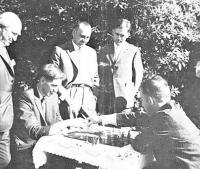
The Alekhine-Chatard Attack
The French Defense is one of the most widely used responses in black’s chess arsenal against 1.e4. It is a known for being a robust and resilient defense that can lead either to boring, maneuvering play or to raging attack and sacrifices. As with any popular openings there is a myriad of variations that all have their pluses and minuses. To name a few are the Classical, Winawer, Tarrasch, Advance and Exchange Variations. I enjoy playing against the French Defense especially in the Winawer Variation where I employ the move Qg4 which was a favorite of the late World Champion, Robert Fischer. I will not be looking at this variation today but I would strongly suggest anyone that is interested to look at the game Fischer-R. Finegold 1963.
As I have said I won’t be looking at the Winawer today but rather at the Classical French which begins after the moves 1.e4 e6 2.d4 d5 3.Nc3 Nf6. White from here has several plans that can come to fruition later or leave the first player's game devoid of life. Lately I have been making use of the move 4.Bg5 pinning the knight to the Queen, which is what I believe to be the most aggressive. Here if black decides to break the pin on the knight and plays 4...Be7 we enter the line that I wish to cover today. I respond to this by playing 5.e5 kicking the knight and after 5…Ne7 I play 6.h4 and the position looks something like this.
It seems that white is sacing a pawn here and indeed he is, but what does white get for that pawn? The answer is an aggressive, tactics filled attack. This opening choice that I have described is called the Alekhine-Chatard attack. This opening centers very much on the half open h file as well as the first player's control of the dark squares. How does the game continue? 6…Bxg5 7.hxg5 Qxg5 and black is a pawn up here, but now white gets an attack of his own, either striking at the exposed queen or at the vulnerable h6 square. I’m guessing that you see the variation 8.Nh3 Qe7 9.Qg4 g6 10.Nf4. Remember the old adage “a knight on the rim is grim”, so you want to get the knight off that h3 square. Now can you see the strike at the h6 square?
Up until here you have seen the setup for the opening. The pieces are set and the game begins in full swing. I have chosen two full game games in this variation as well as half an older game and will include some of my own analysis of the moves played as well as giving some fun variations. The first game that I am going to take a look at is Kasparov-Korchnoi 2003
The second game is Grischuk-Brynell 2002
As you can see from these games there are plenty of tactics and fun to be had in this variation. One of the best things about this enjoyable opening is the record of the opening which is here from the Chess.com database. This opening sports nothing less than an impressive 44.23% chance of a win for White! If you are an attacking player I believe that you will enjoy this opening as either a surprise weapon or as a main line of defense against the classical French. Thanks for the read and I hope that you enjoy the Alekhine-Chatard Attack!

